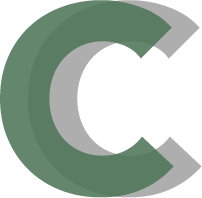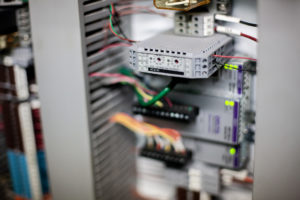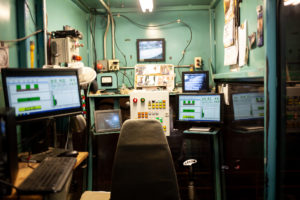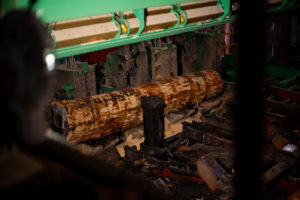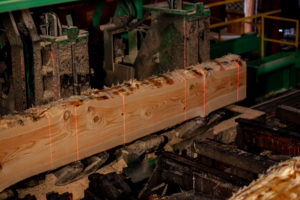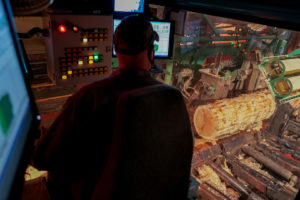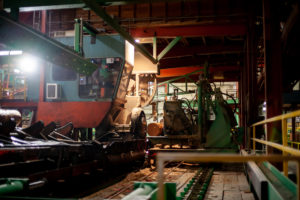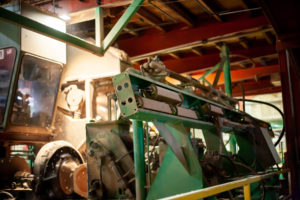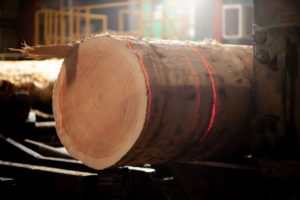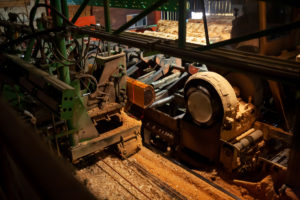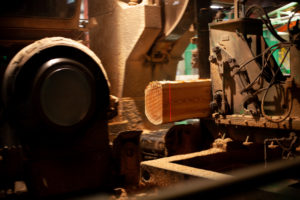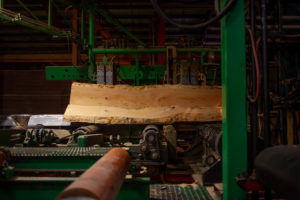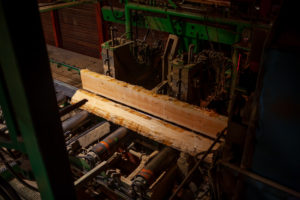The opening face side of a log is scanned by a 3D scanner. An optimal back-side scanner is available. The optimizer computer calculates a cutting solution for the entire log to maximize the value of the products that can be produced downstream. The iterative process involves generating dollar-driven cutting solution scenarios of which the highest dollar-value scenario is chosen. For hardwood sawmills, wade-grade settings are used to determine the appropriate opening face cut.
We are able to give you an optimizing solution with lineal or snapshot scanners.
What is a carriage and why use it. A log carriage is a very versatile primary breakdown machine. Many vendors offer the framework and tracks that make up a carriage. The Cecil Company provides carriage optimization systems, which include a package with 3D scanners, optimization software running on PC computers, and PLC machine control system. The Cecil Company can install new or retrofit existing carriage systems. By upgrading your carriage to an optimized system, your company can gain higher value recovery and increase your profit.
Optimizing System Features
Click on each feature section to see more content and description.
Our Headrig Carriage Optimizer can work as a “one-sided” scanner mounted over the log deck, to scan the Opening Face side of the log only – or we can add “Back-Side” scanning to the back side of the carriage, to provide nearly a full 360-degree scan image of the log. This feature adds recovery and superior log skewing to the optimized log solutions.

Our Headrig Carriage Optimizer offers an option for a “Remote Control Panel” that rides on vibration isolation mounts on the carriage. This is a control enclosure with a Delta RMC knee motion controller and an Allen Bradley I/O module for dog (and other carriage devices) control. This option replaces all of the knee control Servo cables, Temposonic cables, and Multiple Dog function control wires – with a Single Ethernet cable over the carriage pantograph. The devices in the panel, as well as the panel itself, are mounted with vibration isolation mountings to provide reliability on the high vibration carriage.
Allen Bradley PLC and Delta motion control used for all machine control.
- All NBE optimizers have tools for saving scan data, replaying saved files and assessing optimization decisions.
- The optimizer screen dashboard contains production statistics and current solution statistics.
- The supervisor computer enables the user to review past piece solutions.
Visually shows the user the piece that was scanned and the solution that has been computed. The table included with solutions for each scanned piece, allowing the operator to review current and recent solutions.
We save the recent scanned pieces in the history for your review to be able to evaluate your system performance.
The Optimizer software runs on a standard Desktop PC on a Standard Windows Operating System and is fully customized to each sawmill application:
- Each system features 2 identical computers: an Optimization Computer, and a Supervisor Computer.
- Optimizer Computer is devoted full time to dollar-driven, real-time optimization.
- Supervisor Computer provides Windows-based simulations and solution parameter editing.
- Supervisor Computer serves as a “built-in” spare to the Optimizer Computer.
- The Supervisor Computer is not required for production.
How Headrig Carriage Optimizer helped others
Robert worked on a headrig carriage optimization system for us, which he is specialized in. We had an older Inovec system that we ended up updating and going to the Cecil Optimization and using JoeScan for the scan heads. It was a pretty short time frame turnaround. We contracted in February and installed in April 2017.
Everything ended up going really smoothly. We are trying to optimize as best as possible and we are getting the best radius in view. When it comes to optimization, we wanted to see every bit of what we could and it really was not an option to not do backside scanning.
Robert’s great! He is very concise and he knows what he is doing very well. We had no issues with that at all. Ever since we’ve done the upgrade, many times if we had any questions or if we wanted to work on anything, Robert was very responsive.
The performance has been good. We miss fewer backside boards. With our previous system, we’d have to turn, rescan and start over. Without any hesitation, I would recommend others to work with Robert Cecil!
